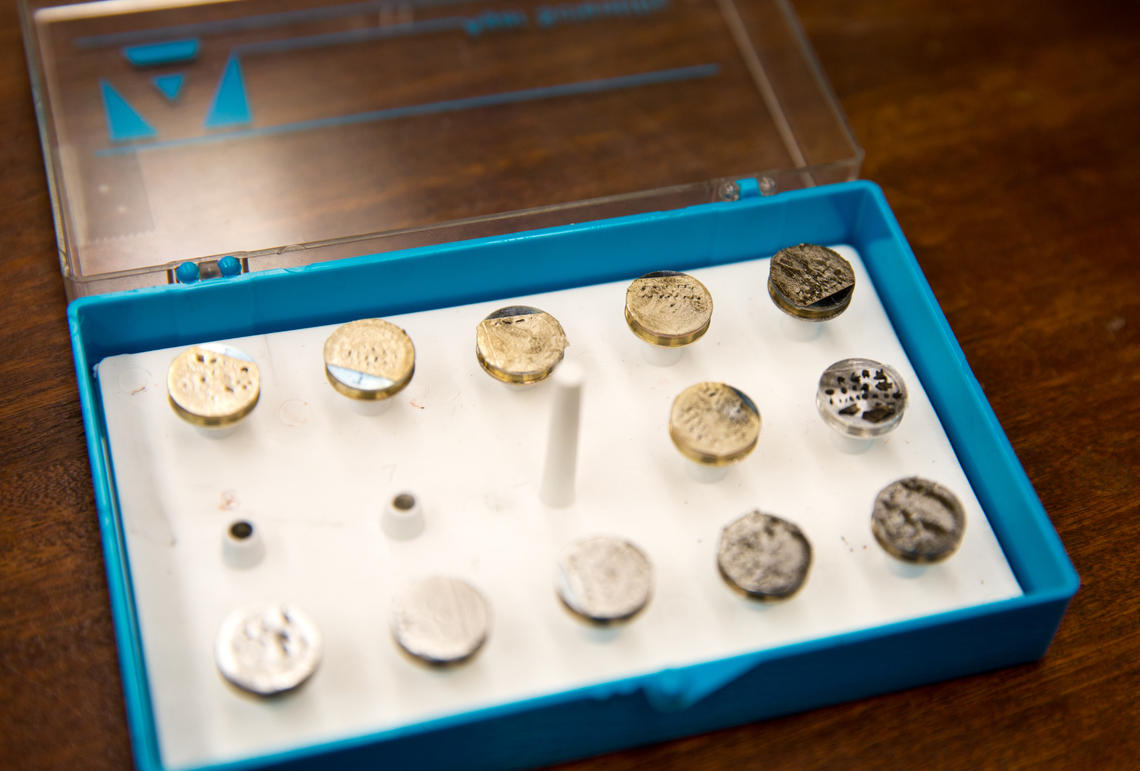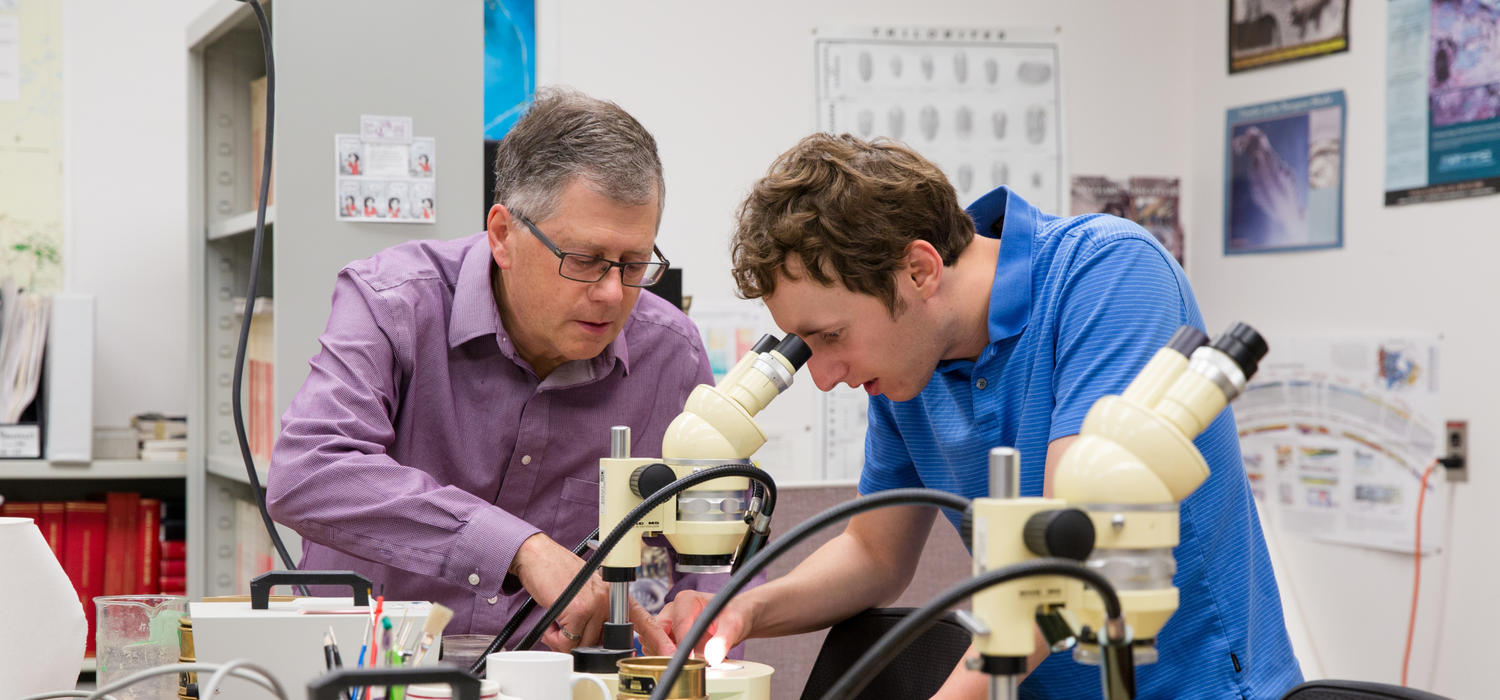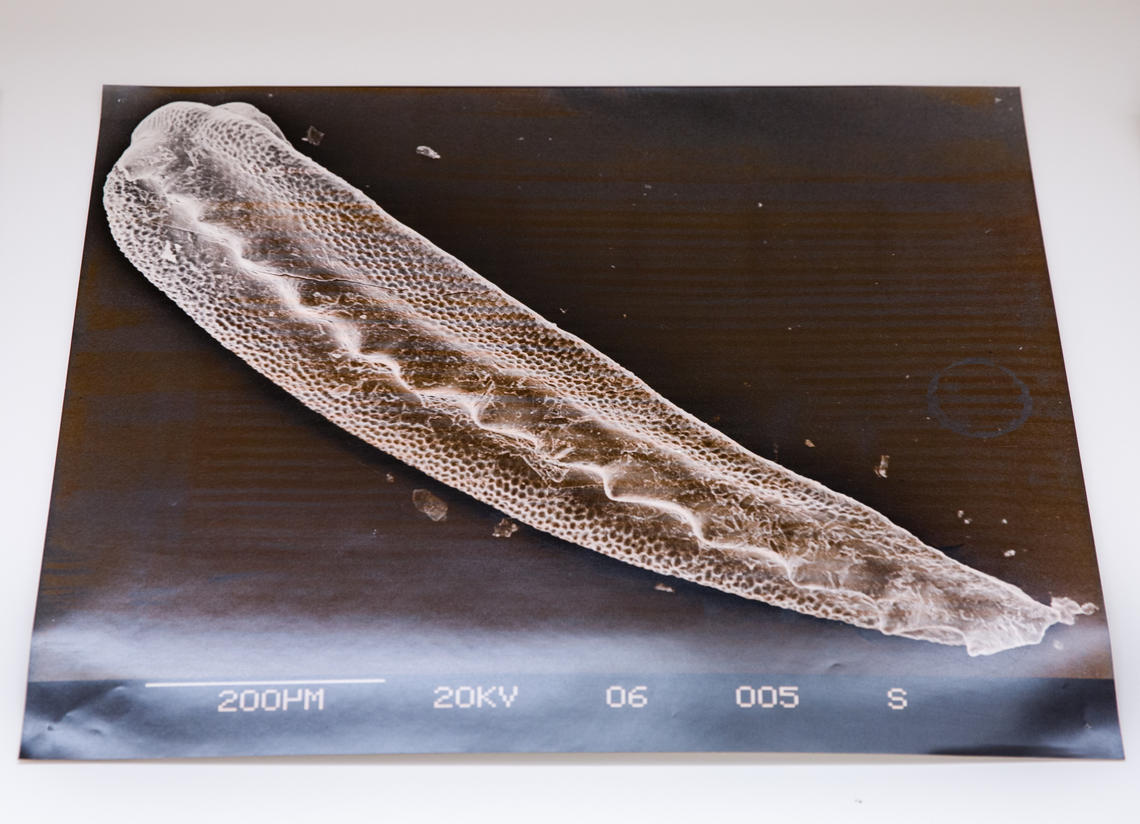
Samples of conodont fossils from Henderson's laboratory.
Riley Brandt, University of Calgary
Aug. 1, 2018

Many outside of the field of paleontology are likely unfamiliar with the term conodonts, which describes fossilized, cone-shaped teeth from ancient animals who died out at the end of the Triassic Period. According to Dr. Charles Henderson, PhD, who studies conodonts in the Department of Geoscience, and many other researchers, the millimetre-sized teeth are the “most useful fossils in the world.” Henderson is pictured above with PhD student David Terrill.
Henderson, PhD student David Terrill, and Dr. Jason Anderson in the Faculty of Veterinary Medicine are co-authors on a new research paper published in the Journal of Analytical Atomic Spectrometry that uncovers the origin of these mysterious and abundant fossils.
Paradigm-changing paper helps answer longtime mystery of conodont biology
Conodonts occur in almost any marine rock across the world, from China to Iran to the Arctic.
“Since distinctive forms are found everywhere in a certain range of time, we can use them as an evolutionary time clock,” Henderson explains. “As soon as you can tell time, you can answer a lot of different kinds of problems in geology. If you want to learn about mountain building or extinctions, you need to know something about the age of the rocks. If you want to explore for oil and gas, the presence of conodonts can be used to identify the best levels of rock for exploration, for example in the Lower Triassic Montney Formation.”
In a bit of a paradox, conodonts have been used as index fossils for decades, while at the same time paleobiologists have been trying to figure out what kind of animal they were.
Although there is still some controversy, most paleontologists recognize that conodonts are Chordates and likely vertebrates, of which there are two distinct groups: Gnathostomes, which are jawed vertebrates, and Cyclostomes, which have round mouths like hagfish. Conodonts are most often assigned to the former group. In his recent research, Terrill applied new geochemical and engineering techniques and instrumentation that rather conclusively placed conodonts in the Cyclostomes category.
“Beginning around the 1990s, most researchers came to generally agree that conodonts were the early ancestors of jawed fish,” Terrill explains. “So they’re quite often included as jawed fish with no jaws.”
“Our work suggests that they’re closer to modern lampreys, which are a modern jawless fish,” he says. “The distinction doesn’t seem huge from that sort of description, but from a paleontological perspective you’ve got two branches of the vertebrates and we’ve just switched it.”
Adds Henderson, “When you’re dealing with the fossil record, it’s almost impossible to prove something 100 per cent. In this case, our detailed phylogenetic analysis has given us evidence beyond a reasonable doubt. Anybody that is looking at the biology of conodonts is going to have to read and cite our paper.”

Samples of conodont fossils from Henderson's laboratory.
Riley Brandt, University of Calgary
New technology techniques turn up surprising result
To reach this conclusion, Terrill used work by a previous graduate student supervised by Henderson, who studied the chemistry of conodont teeth as a starting point. Terrill’s results from a field emission electron scanning microscope, which can take high magnification pictures and analyze the chemistry of all elements in the teeth simultaneously, showed that a significant amount of sulfur existed in the middle of the tooth – something that had not previously been reported as an essential component of conodont chemistry.
“For the most part, conodont teeth are like ours — made of calcium and phosphorous and oxygen — so to see sulfur was strange,” Terrill says. Further analysis suggested that at least one-third of the sulfur measured was almost certainly biological in origin. In biology, sulfur is a key part of the keratin that makes up fingernails, skin, and hair.
“From a scientist’s standpoint, a lamprey’s tooth is entirely made of keratin. So the fact that we’re finding evidence of keratin inside a conodont’s tooth when you don’t find that in our teeth (or fish teeth), then this strengthens the relationship between it and a lamprey,” explains Terrill.
Another relationship that may be worth examining is the relationship between conodonts and the 66,000+ species of vertebrates on Earth. “There are other fossils that have more of a developed spinal cord structure, but conodonts are the first vertebrates to mineralize some of their tissue – making bones and teeth. That’s not present in the earliest vertebrates, but conodonts seem to have figured out a way to do that,” Terrill says. “It’s not such a stretch that conodonts could be the ancestors of all vertebrates.”
Says Henderson, “There may not be a direct lineage, but there’s certainly a common ancestor somewhere back in time that would unite the conodonts and these other groups.”
Terrill will continue his PhD studies on conodont paleobiology by working for four months in Germany with Dr. Emilia Jarochowska at Erlangen beginning in August. They will investigate the trophic structure of conodonts using various geochemical techniques and try to decipher what conodonts may have eaten. He received a grant from the German Academic Exchange Service in support of this study.
Understanding Earth’s evolving systems
As part of its strategic direction for 2017-2022, the Faculty of Science is directing its research efforts toward four Grand Challenges. The Grand Challenges harness our current strengths, look to future opportunities, and are a framework for doing research that impacts our community and the world. Research under the Grand Challenge Understanding Earth’s Evolving Systems includes Earth as a system from the core to the magnetosphere, biodiversity and conservation, and the intersection of the natural and built worlds.
How you can participate in a research study at the University of Calgary

A cross-section of a conodont, which occur in almost any marine rock across the world.
Riley Brandt, University of Calgary